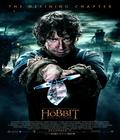It's been two years since audiences began the cinematic adventures of Bilbo Baggins (Martin Freeman). "The Hobbit: An Unexpected Journey" introduced audiences to Bilbo and the company of dwarves, as well as highlighted some of the dangers of Middle-earth. Last year, in "The Hobbit: The Desolation of Smaug," we saw the meat of the story, even if the film did end on an abrupt and annoying cliffhanger. "The Hobbit: The Battle of the Five Armies" picks up exactly where the last film left off and ends with a callback to the very beginning of "The Lord of the Rings: The Fellowship of the Ring."
The first 15-20 minutes of "The Battle of the Five Armies" covers Smaug's attack on Lake-town. Although the film cuts right to the action, it all feels rushed and anti-climatic, perhaps because there is no build-up. All of the momentum from "The Desolation of Smaug" is lost, and what should have been an impressive ending to the prior movie ends up feeling tacked-on here. It essentially serves as a prologue that has little to do with the core of the last film.
As the title implies, this installment centers on a massive battle, as the various forces of men, dwarves, elves and orcs all vie for control of the Lonely Mountain. What was essentially an epilogue to the main story in the original novel has been put front-and-center here. Unfortunately, the central battle fails to impress, as it is more of a skirmish than anything else.
Compared to the opening prologue scenes in "The Fellowship of the Ring" or the Battle of Helm's Deep as portrayed in "The Lord of the Rings: The Two Towers," the main conflict is simply small and unimpressive. We never see countless fighters on-screen. Each of the five armies appears to consist of hundreds, rather than thousands, of individuals, which just adds to the impression of smallness.
Ironically, where the film is at its best is when it is away from the battle and focusing directly on the characters. Watching Thorin Oakenshield's (Richard Armitage) slow descent into madness is impressive. Armitage does an exceptional job here, highlighting moments of lucidity before dropping back into his obsessive gold lust as a result of dragon sickness. The interactions between Bilbo and Thorin are not to be missed.
Evangeline Lilly also makes her mark as Tauriel. An original character created for the prior film, Lilly infuses Tauriel with more heart than any of the others seen on-screen. Torn between her loyalty to Legolas (Orlando Bloom) and her love for the dwarf Kili (Aidan Turner), Tauriel's inner conflict is just as much a core part of the story as any of the original elements.
Where the action in the film shines is when it steps away from the main battle. There is a short sequence at Dol Guldur, which has Elrond (Hugo Weaving), Galadriel (Cate Blanchett) and Saruman (Christopher Lee) rescuing Gandalf (Ian McKellen). Despite being small in scope, the choreography seen here and the energy from the individual actors make it the most impressive fight in the entire film. Weaving moves around like a master combatant, but Blanchett takes the spotlight when she lets loose her inner rage. This is the moment that stands out above all else.
Another strong character is Bard the Bowman (Luke Evans) and how he quickly has to come to terms with being a leader, while at the same time protecting his family. Much like the sequences with Bilbo, Tauriel and Thorin, what's here is good but feels limited. It's almost as if director Peter Jackson decided to cut much of the character development to focus on the action. Watching the movie, you could almost envision exactly which sequences will be extended when the inevitable extended edition hits home video.
Looking back at the entire trilogy, the decision to stretch "The Hobbit" into three films was probably a mistake. The story could have easily been told in two, and "The Battle of the Five Armies" suffers for it. Everything here feels like it is necessary connecting tissue, but it never punches above its weight, despite the best efforts of the cast.
If you enjoyed the first two films, then settle in for the concluding segment of "The Hobbit." It won't blow you away, but it will be an enjoyable evening. On the other hand, if you haven't seen the prior films, don't bother jumping in here. Unlike "The Desolation of Smaug," "The Battle of the Five Armies" doesn't work as a stand-alone installment.
Score: 6.0/10
"The Hobbit: The Battle of the Five Armies" is rated PG-13 and has a running time of 2 hours and 24 minutes. It is showing in 2-D, 3-D, IMAX 3-D and HFR 3-D.
More articles about The Hobbit: The Battle of the Five Armies











 The Hobbit: The Battle of the Five Armies is the conclusion of the adventures of Bilbo Baggins, Thorin Oakenshield and the Company of Dwarves. The dwarves have reclaimed the wealth of their homeland, but they must face the consequences of unleashing the dragon Smaug on Lake-town.
The Hobbit: The Battle of the Five Armies is the conclusion of the adventures of Bilbo Baggins, Thorin Oakenshield and the Company of Dwarves. The dwarves have reclaimed the wealth of their homeland, but they must face the consequences of unleashing the dragon Smaug on Lake-town.

































